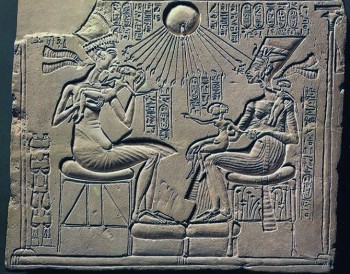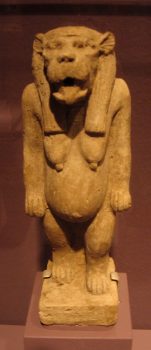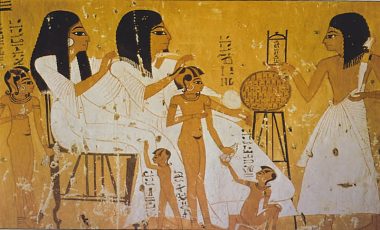Getting married in Ancient Egypt (and also in the other ancient civilizations) was an important business because the family was the most valuable institution in social life, next to the theocracy itself. Generally, Ancient Egyptians have married inside their social classes. The man was usually married between the ages of 16 and 20, or as soon as he chooses potential craft with the aim to earn money for his family. Women usually married at the age of about 13 years, or immediately after the puberty. It was not uncommon for an old man to marry a girl at puberty. Ancient Egyptian had marriage and betrothal ceremonies different compared to moderns. Unfortunately, there is not too much information about these ceremonies, but from some sources, it’s possible to give a short view.
During the Egyptian Late period, contract between husband and wife about their property was often created by the upper class between husband and father of the bride. The marriage contract consisted of the date of the pharaohs rule, together within the wife and husband names and names of parents. Also, within names, there was occupation of the husband and wife. At the end of contract, the scribe also sign together within the names of the marriage witnesses and finally the name of settlement whom they belong. Marriages in Egyptian royal house were celebrated with as a great ceremony. Pharaoh often, of course for political reasons, married several women’s, or foreign princesses. During the marriage ceremony, husband and wife offered gifts to the gods. They also exchange gifts between each other and brides father. It was important to give a present to brides father, especially if he was an important person and if he was possibly a foreign ally in following days. Fathers often advised their sons how to behave towards their married women:
“Do not control your wife in her house,
When you know she is efficient;
Don’t say to her: “Where is it? Get it!”
When she has put it in the right place.
Let your eyes observe in silence,
Then you recognize her skill;
It is joy when your hand is with her,
there are many who don’t understand this.
If a man desists from strife at home,
He will not meets its beginnings.
Every man that founds a household
should hold back the hasty heart.”
Among Egyptian people in villages, there was a gift for a bride, mentioned as ‘shepensemet’. Shepensemet was probably a gift to the brides father, as an exchange for taking his daughter away from the house. This word was often written after years of married woman and when she has given birth to one or more children. The Egyptians loved the sensual pleasures. Their myths were full of different kinds of sexual activity. They represent the universe with Nut, the goddess of the night sky, which is crowned in the form of an arch to his brother Geb, the god of earth, who is in the erection. Adultery, on the other hand, was a definitive taboo, especially on the side of a woman, and she could be seriously punished including amputation of her body parts, stoning or burning on the wheel. Divorce was simple. A husband or wife could only divorce by expressing this desire, even if they did not have specific grounds like adultery or infertility. Unlike the in ancient Athens and Rome, the children from the marriage belonged to mother, and they went with her. According to believe, Egyptians thought they would find themselves in court after death, in front of god Osiris, and then he would accept them to walk across a Field of Reeds where they would be united with their family and property.
The position of a woman in marriage



Men and women in Ancient Egypt seem almost equal in marriage, and women have enjoyed greater rights, such as the right to dispose of property or initiation of divorce. In the Egyptian art, women were often depicted as supporting or encompassing their husband, while husband and wife often call each other as “brother” or “sister”, again, suggesting a relationship of equal. Hemet was usually a word in documents meaning female partner or wife, and it was known from the period of Old Kingdom of Egypt. From the period of XVI century BC, instead of “hemet” Egyptian more often used word ‘senet’ which means sister. The difference between “hemet” and “senet” was that word “hemet” more often used as religious meaning of wife. From the period of the Middle Kingdom of Egypt in marriage contracts appears word ‘hebsut’ and its suggest that this word was also synonymous with word ‘hemet’ or wife. The words ‘ankhet en niut’ along with the word ‘nebet per’ probably seems to mark a married woman. These words differ depending on where they appeared. The word “Hebsut’ were not commonly used in monumental contexts. The word ‘hemet’ was often used in tombs, stele or statues. As well the word ankhet-en-niut means citizens from the period of Egyptian New Kingdom, and this word appeared in hieratic form, while the word ‘nebet per’ symbolized “mistress of the house” and this word were more often on monumental buildings. In case when children were born in marriage, that marriage Ancient Egyptians considered as successful. Therefore, the main duty of an Egyptian woman in marriage was to give birth to as many children as possible because the death rate in Egypt was too high. The duty of woman in marriage was also to take care of children and the home.



Ancient Egyptian learned to apply some techniques of pregnancy tests. The pregnancy tests were described in papyrus. One test was taking the pulse, investigate the color of the skin and condition of the woman, and another test suggest checking the urine on pots of barley. Within this test, Egyptians tried to predict whether boy or girl will be born. The woman needed to urinate daily on emmer wheat (Triticum dicoccum), and barley wheat (Hordeum vulgare). If sprouted first barley wheat, a woman will give birth to a girl. The child would be male when the emmer wheat sprouted first. If any of these plants did not sprout at all, then the woman probably was not pregnant.
During the Old Kingdom within squatting position on two bricks known as Birth bricks woman gave birth. On this way, woman personified the godmother Meshkhenet. Later during the period of Egyptian New Kingdom further, bricks probably was built in small room or on the roof of the house, pavilion in the garden. In this room or pavilion, woman gave birth. She was also spent the first days and weeks together within infant. This ceremony was shown on a piece of pottery (ostraca) found in the ancient village Set Maat (Deir-el-Medina).
After woman gave birth the whole process not completed because she need to spent some time in isolation in order to get purification. She spent time in “birth room” decorated with motive of Tawaret (deity with the head of hippopotamus and stomach of a pregnant woman) and Bes. These two gods according to believe protects mothers and their newborn children. After she complied period of purification (couple of weeks) she was able to join her community. Because the childhood was full of dangers and these deities need to protect the child after birth.



Despite producing children in marriage, Egyptian woman was not only limited to house. Often due to necessity, a married woman employed herself in various occupations and professions.
Incestuous marriage
Incest in marriage was very common for Ancient Egyptian. For example Tutankhamun’s wife Ankhesenamun was also his half-sister. Before marrying Tutankhamon, Ankesenamun was married to his father Akhenaten. Recently research about the death of Tutankhamun also suggest that he was born from incestuous marriage. Cleopatra also married both of her brothers Ptolemy XIII and Ptolemy XIV. One of the most visible examples of the incestuous-born child was pharaoh Amenhotep, who, supposedly scientists, was born of the third generation of marriages among brothers and sisters.
References
- Henry George Fischer: Egyptian Woman of the Old Kingdom And of the Heracleopolitan Period, New York 2000;
- Troy D. Allen, The Ancient Egyptian Family: Kinship and Social Structure, New York 2009;
- Hunt, Norman Bancroft, Living in Ancient Egypt. New York 2009;
- Marriage and Family Life in Ancient Egypt by Ray Erwin Baber, Social Forces, Vol. 13, No. 3 (Mar., 1935)
